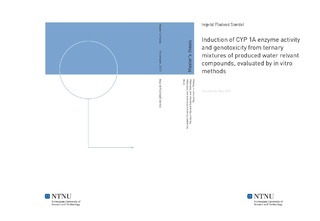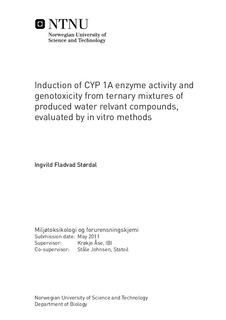| dc.contributor.advisor | Krøkje, Åse | nb_NO |
| dc.contributor.advisor | Johnsen, Ståle | nb_NO |
| dc.contributor.author | Størdal, Ingvild Fladvad | nb_NO |
| dc.date.accessioned | 2014-12-19T13:11:44Z | |
| dc.date.available | 2014-12-19T13:11:44Z | |
| dc.date.created | 2011-06-16 | nb_NO |
| dc.date.issued | 2011 | nb_NO |
| dc.identifier | 423830 | nb_NO |
| dc.identifier | ntnudaim:6567 | nb_NO |
| dc.identifier.uri | http://hdl.handle.net/11250/244733 | |
| dc.description.abstract | Produced water is a complex mixture discharged to sea in high volumes containing compounds at low concentrations. Compounds in mixtures can modify each other s expected toxic effect predicted from single exposure, and to obtain information about potential interactions is important. Carbazole is present in produced water and is suggested to contribute to produced waters potential of modifying cytochrome P450 (CYP) activity. Information on toxic effect of carbazole in relation to produced water is limited. Carbazole is included in this project to study its potential for modifying CYP 1A activity singly and in mixtures. The aromatic and phenolic fractions of produced water are significant contributors to toxicity and concentration of organic compounds in produced water. As representative compounds of these fractions, benzo(a)pyrene (BaP) and 2,5-dimethylphenol (DMP) are included in this master project. Biotransformation of harmful compounds is often initiated by CYPs catalysing oxidation reactions. Modified CYP 1A protein or activity is an indication of interaction between a compound and the biological system. Biotransformation catalysed by CYP 1A can produce reactive oxygen species (ROS) and reactive metabolites. Increased contaminant load can deplete reduced glutathione (GSH) through increase in conjugation reactions. In addition to being an important conjugate, GSH is also an important antioxidant. With potential both to increase extent of DNA damage by increasing levels of ROS and producing reactive metabolites, and interfere with glutathione dependent defence protecting against oxidative stress, compounds interacting with CYP 1A and conjugation enzymes are suggested to contribute to DNA damage. The aims of this master project were to determine carbazoles potential for modifying CYP 1A activity measured as ethoxyresorufin-O-deethylase (EROD) activity, to evaluate interaction in ternary mixtures with carbazole and two compounds representing fractions contributing to toxicity of produced water, and also to study correlation between biotransformation activity and genotoxicity by measuring DNA double strand breaks (DSB). The aims were achieved by studying single compounds and ternary mixture in vitro in the continuous cell line PLHC-1. Concentrations of the three compounds in the ternary mixtures were varied using a statistical design. Results were analysed using partial least squares projection to latent structures (PLS). Concentrations of the compounds included in the design were determined from cytotoxicity results, EROD concentration effect curves for single compounds and concentrations measured in the marine environment. It was hypothesized that compounds will modify EROD activity in PLHC-1 differently when present in ternary mixtures compared to single exposure. It was further suggested that ternary mixtures inducing high EROD activity also will enhance formation of DNA DSB in PLHC-1 cells. Carbazole was suggested to modify EROD activity induced by the other compounds. Exposure of PLHC-1 to BaP singly significant induced EROD activity. Carbazole induced EROD activity slightly, and significant for the highest concentration in one replicate. An overall non-significant decrease in EROD activity was seen in PLHC-1 exposed to DMP. Exposure of PLHC-1 to ternary mixtures resulted in significant and positive PLS regression coefficient for both BaP and carbazole. The crossed term carbazole×DMP decreased EROD activity significantly. Squared terms for all three compounds were significant, equal and negative.The results indicate that potential of carbazole at inducting CYP 1A is different alone compared to when it is present in mixture. Carbazole is suggested to contribute to EROD inducing potency in the ternary mixtures. Effect of carbazole on EROD activity is indicated to be dependent on co-exposed compounds. How EROD activity is modulated when exposed to DMP is suggested to be dependent on exposure conditions. The significant substantial square terms indicate that all three compounds interact with catalytic EROD activity at higher concentrations. Catalytic EROD activity is presumed to be a good indication of potential interaction between compounds and biological systems. Determining extent of DNA damage by electrophoretic separation of DNA did not give consistent result. Electrophoretic separation of DNA from PLHC-1 is assumed to be more pertinent for determining genotoxicity of certain metals in PLHC-1. Statistical design and projection techniques are considered valuable tools when assessing toxicity of mixtures. | nb_NO |
| dc.language | eng | nb_NO |
| dc.publisher | Institutt for biologi | nb_NO |
| dc.subject | ntnudaim:6567 | no_NO |
| dc.subject | MFORU Miljøtoksikologi og forurensningskjemi | no_NO |
| dc.subject | | no_NO |
| dc.title | Induction of CYP 1A enzyme activity and genotoxicity from ternary mixtures of produced water relvant compounds, evaluated by in vitro methods | nb_NO |
| dc.type | Master thesis | nb_NO |
| dc.source.pagenumber | 108 | nb_NO |
| dc.contributor.department | Norges teknisk-naturvitenskapelige universitet, Fakultet for naturvitenskap og teknologi, Institutt for biologi | nb_NO |

